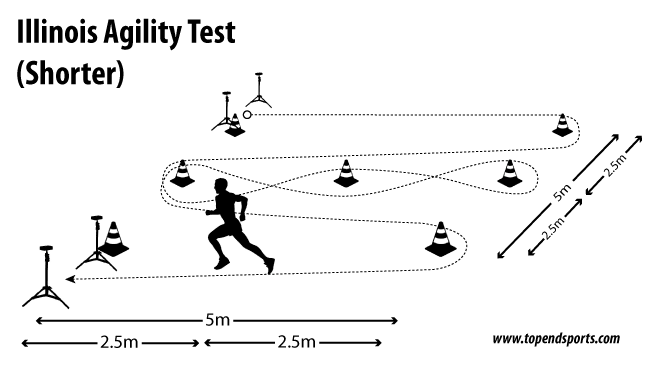The original Illinois Agility Test is a popular test of agility. The original version may be heavily influenced by the ability to sprint quickly over short distances instead of measuring the ability to change direction. Also, it can take longer than 15 seconds and fatigue can play at part. This modified version, proposed by Hachana et al. (2014), is shorter (half the length) but has the same movement patterns remain. The original version is still most commonly used and this modified version is just presented as a possible alternative. There is another modified version, with the same field size as the original but with less 10m sprints.
test purpose: to test running agility using various turns and movements over a shorter distance than the standard Illinois Agility Test.
equipment required: flat non-slip surface, 7 marking cones, stopwatch, measuring tape, timing gates (optional)
pre-test: Explain the test procedures to the subject. Perform screening of health risks and obtain informed consent. Prepare forms and record basic information such as age, height, body weight, gender and test conditions. Measure and mark out the test area using cones. Check timing gate equipment and calibrate if required. See more details of pre-test procedures.

course layout: The length of the course is 5 meters by 5 meters. Four cones are used to mark the corners of the square (start, finish and the two turning points). Another three cones are placed down the center 2.5 meters apart.
procedure: Participants start in a standing position (unlike the original test in which they lie on their front with the head to the start line. Using the standing position enables timing gates to be used. When ready, the player runs forward 5 meters to run around a cone, then back 5 meters, then runs up and back through the slalom course of three cones. Finally, the athlete runs another 5 meters up and back past the finishing cone, at which the timing is stopped. (see Illinois test video examples). Several trials should be completed, with the best score recorded.
advantages: This is a simple test to administer. Also, the player's ability to turn in different directions and at different angles are tested. The test is considered an improvement on the standard Illinois Agility Test as it can be completed in a quicker time (so fatigue plays a lesser part) and the straight running is over a shorter distance.
disadvantages: The choice of footwear and the running surface can effect times greatly. Results can be subject to timing inconsistencies, which may be overcome by using timing gates. There are no norm values available for this modified version.
references:
- Hachana Y, Chaabène H, Ben Rajeb G, Khlifa R, Aouadi R, Chamari K, et al. (2014) Validity and Reliability of New Agility Test among Elite and Subelite under 14-Soccer Players.
- Rouissi, M., Chtara, M., Berriri, A., Owen, A., & Chamari, K. (2016). Asymmetry of the Modified Illinois Change of Direction Test Impacts Young Elite Soccer Players' Performance. Asian journal of sports medicine, 7(2), e33598. doi:10.5812/asjsm.33598
Similar Tests
- Illinois Agility Test (Modified) — a modification of the standard Illinois test which reduces some straight sprinting.
- Illinois Agility test — agility run involving 180 degree turns and slalom running
- T-Test — running a T-shape course involving forward, lateral, and backwards running.
- Zig-Zag Test
- Figure-of-Eight Agility Run Test
Related Pages
- See rating norm scores for the Illinois Test
- Other agility tests
- See Illinois test video examples


 Current Events
Current Events